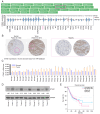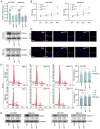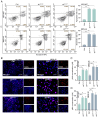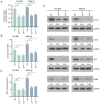Targeting ETHE1 inhibits tumorigenesis in vitro and in vivo by preventing aerobic glycolysis in gastric adenocarcinoma cells
- PMID: 40264823
- PMCID: PMC12012436
- DOI: 10.3892/ol.2025.15032
Targeting ETHE1 inhibits tumorigenesis in vitro and in vivo by preventing aerobic glycolysis in gastric adenocarcinoma cells
Abstract
Gastric adenocarcinoma (GAC) is a prevalent form of cancer that frequently displays abnormal metabolism characterized by increased aerobic glycolysis. Therefore, inhibition of glycolysis may exhibit therapeutic potential for the management of advanced or recurrent gastric cancer. Analysis of ethylmalonic encephalopathy protein 1 (ETHE1) expression levels in 30 pairs of cancerous and paracancerous tissues, and 50 tumor tissue sections collected from patients with GAC revealed that ETHE1 expression was upregulated in cancerous tissues compared with in paracancerous tissues. Advanced tumor stage, lymph node metastasis and Tumor-Node-Metastasis stage were associated with high ETHE1 expression. Knockdown of ETHE1 expression in GAC cells resulted in a significant inhibition of cell proliferation and in cell cycle arrest, accompanied by downregulated levels of cyclin D1 and cyclin-dependent kinase 4. ETHE1 knockdown also resulted in increased apoptosis of GAC cells, and increased caspase-3 and caspase-9 activity. Additionally, the expression levels of proteins associated with aerobic glycolysis were downregulated following ETHE1 knockdown, which may reduce glucose consumption, lactic acid production and ATP levels. In the in vivo experiments, suppressed tumor growth and increased tumor cell apoptosis were observed in the xenograft tumor model in animals injected with ETHE1-knockdown GAC cells. In summary, knockdown of ETHE1 inhibited aerobic glycolysis, promoted apoptosis and inhibited tumor cell proliferation in GAC cells. These results highlight ETHE1 as a promising molecular target for the treatment of GAC potentially using an adjuvant to target it, offering a novel approach in the exploration of targeted therapeutic drugs for GAC.
Keywords: aerobic glycolysis; apoptosis; ethylmalonic encephalopathy protein 1; gastric adenocarcinoma; tumor growth.
Copyright: © 2025 Li et al.
Conflict of interest statement
The authors declare that they have no competing interests.
Figures







Similar articles
-
ETHE1 overexpression promotes SIRT1 and PGC1α mediated aerobic glycolysis, oxidative phosphorylation, mitochondrial biogenesis and colorectal cancer.Oncotarget. 2019 Jun 18;10(40):4004-4017. doi: 10.18632/oncotarget.26958. eCollection 2019 Jun 18. Oncotarget. 2019. PMID: 31258845 Free PMC article.
-
Rab25 acts as an oncogene and participates in the regulation of aerobic glycolysis via PKM2 in gastric adenocarcinoma.Transl Cancer Res. 2021 Feb;10(2):790-805. doi: 10.21037/tcr-20-2597. Transl Cancer Res. 2021. PMID: 35116410 Free PMC article.
-
ETHE1 Accelerates Triple-Negative Breast Cancer Metastasis by Activating GCN2/eIF2α/ATF4 Signaling.Int J Mol Sci. 2023 Sep 26;24(19):14566. doi: 10.3390/ijms241914566. Int J Mol Sci. 2023. PMID: 37834012 Free PMC article.
-
Knockdown of HMGB1 inhibits growth and invasion of gastric cancer cells through the NF-κB pathway in vitro and in vivo.Int J Oncol. 2014 Apr;44(4):1268-76. doi: 10.3892/ijo.2014.2285. Epub 2014 Jan 28. Int J Oncol. 2014. PMID: 24481712
-
Identification of a novel homozygous nonsense variant in a Chinese patient with ethylmalonic encephalopathy and a genotype-phenotype spectrum review.Clin Chim Acta. 2020 Oct;509:8-17. doi: 10.1016/j.cca.2020.05.051. Epub 2020 May 30. Clin Chim Acta. 2020. PMID: 32485156 Review.
References
LinkOut - more resources
Full Text Sources
Research Materials
